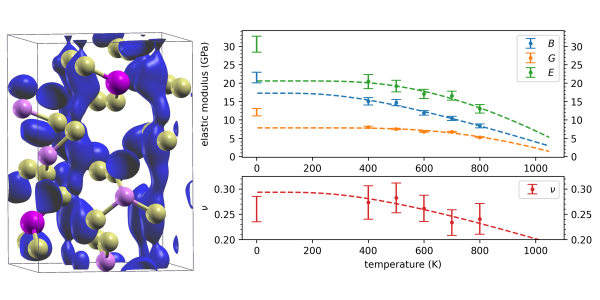Solids that are also liquids: elastic tensors of superionic materials
By Carey Sargent, EPFL, NCCR MARVEL
Understanding the elastic properties of solid-state ionic conductors, also known as superionic materials, is a crucial challenge in developing the solid-state electrolytes (SSEs) that could replace the liquid organic electrolytes used today, thereby improving safety in commercial Li-ion batteries.
While first-principles calculations applied to the elastic tensors of SSEs routinely exploit static density-functional theory (DFT) calculations of total energies or stresses for chosen configurations under applied strains, these static methods might be not appropriate for superionic materials. This is because the Li ions are very mobile at ambient temperatures in such materials, leading to dynamical disorder that plays a significant role: atoms do not simply vibrate around their equilibrium positions, but they exhibit quasi-liquid behavior, which can be captured only with statistical methods based on the sampling of the whole configuration space.

Figure 1: a) Isosurface of Li-ion probability density for LGPS, showing the superionic character of these materials. b) Elastic moduli for LGPS at different temperatures, calculated with dynamical sampling (T > 400 K) and with static stress-strain relations in different stable configurations (T = 0 K), showing the overestimation of the elastic response of these materials by the latter approach.
In the paper “Solids that are also liquids: elastic tensors of superionic materials,” recently published in npj Computational Materials, NCCR MARVEL researchers Giuliana Materzanini, now at UC Louvain, and Tommaso Chiarotti and Nicola Marzari at EPFL, apply a fully dynamical approach to recover the elastic tensors and elastic moduli of superionic materials. This is based on the Parrinello-Rahman method of calculating the average covariance of the strain during extensive first-principles molecular dynamics simulations. The team was thus able to obtain reference results for the elastic constants and moduli of three benchmark oxide and sulfide SSEs. The results show that static methods overestimate the elastic response by a significant amount, between 25% and 50%.
“People in the solid-state-ionics community didn't see an issue in calculating the elastic constants of such materials with static methods—this was kind of an established protocol,” Materzanini said. “We came up and said, ‘Are we sure we are doing the right thing?,’ and now we know the answer: not really, at least for the materials studied here.“
The researchers explain their findings pointing out the quasi-liquid nature of the superionic materials. This makes them compliant, a feature that can only be captured by taking into account the continuous migration of the mobile ions, even at room temperature. The results, especially the overestimation seen with static methods with respect to the proper dynamical treatment, show how important it is to address the elastic properties of superionic conductors with dynamical sampling. The work also provides computational reference results, which had not previously been available to the community, the researchers said.
Additional computational and experimental investigations are warranted, they wrote in the paper. This is both because of legitimate growing interest in the mechanical properties of superionic materials for all-solid-state-battery technologies, as well as by the fact that in addition to numerous elastic properties, some mechanical properties outside the elastic regime—fracture toughness, fragility and shear strength to name just a few—are also often predicted starting from the elastic moduli. This further underscores the importance of accurate measurements or predictions, the scientists said.
References:
G. Materzanini, T. Chiarotti & N. Marzari. Solids that are also liquids: elastic tensors of superionic materials. npj Comput Mater 9, 10 (2023).
Low-volume newsletters, targeted to the scientific and industrial communities.
Subscribe to our newsletter